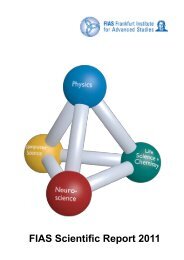FIAS Scientific Report 2010 - Frankfurt Institute for Advanced Studies ...
FIAS Scientific Report 2010 - Frankfurt Institute for Advanced Studies ...
FIAS Scientific Report 2010 - Frankfurt Institute for Advanced Studies ...
Create successful ePaper yourself
Turn your PDF publications into a flip-book with our unique Google optimized e-Paper software.
2. Project “SECO”<br />
FP7-2008-216593<br />
Co-PI C. v.d. Malsburg<br />
Period 01.03.2008-28.02.2012<br />
Amount subproject <strong>FIAS</strong>: Euro 425.306<br />
Collaborators: Urs Bergmann, Christoph von der Malsburg, Junmei Zhu, Alexander Schmid, Tomas Fernandes<br />
This project is funded under the European program “Bio-ICT convergence”. The project’s full title is “Self-<br />
Constructing Computing Systems”. The aim of the integrated project is to model the ontogenetic growth of<br />
neural circuits under genetic control. The <strong>FIAS</strong> subproject has two aims. The first is to model the pre-natal and<br />
post-natal self-organization of the specific circuit patterns that have been used as the basis of the <strong>FIAS</strong> invariant<br />
object recognition system developed in the DAISY project. The essential aims of this part of the project have<br />
been achieved in simple <strong>for</strong>m within the reporting year. The second aim is the development of methodology<br />
<strong>for</strong> the semi-numerical analysis of sets of differential equations describing self-organizing systems, applied<br />
especially to network self-organization. Some applications to ontogenesis and to visual function have been<br />
published.<br />
Related publications in <strong>2010</strong>:<br />
1) Urs Bergmann and C. von der Malsburg, A Bilinear Model <strong>for</strong> Consistent Topographic Representations,<br />
International Conference on Artificial Neural Networks (ICANN), <strong>2010</strong>.<br />
2) Junmei Zhu, Urs Bergmann and C. von der Malsburg, Self-Organization of Steerable Topographic Mappings<br />
as Basis <strong>for</strong> Translation Invariance, International Conference on Artificial Neural Networks (ICANN),<br />
<strong>2010</strong>.<br />
3) Urs Bergmann and C. von der Malsburg, Self-Organization of Topographic Bilinear Networks <strong>for</strong> Invariant<br />
Recognition, Neural Computation. In second review, 2011.<br />
4) Junmei Zhu, Self-organization of two interacting winner-take-all systems, In Proceedings International Joint<br />
Conference on Neural Networks (IJCNN), <strong>2010</strong>.<br />
3. Project “PLICON”: Plasticity and Learning in Cortical Networks<br />
Collaborators: Dana Ballard 3 , Guido Marco Cicchini 2 , Arthur Franz 1 , Mary Hayhoe 3 Manu Punnen John 1 ,<br />
Prashant Joshi 1 , Africa P 1 , Constantin Rothkopf 1 , Cristina Savin 1 , Lisa Scocchia 1 , Paul Schrater 4 Brian<br />
Sullivan 3 , Jochen Triesch 1 , Thomas Weisswange 1<br />
1 <strong>FIAS</strong>, 2 University of Florence, and <strong>Institute</strong> of Neuroscience, National Research Council, Italy, 3 University of Texas<br />
Austin, 4 University of Minnesota<br />
The brain is a very plastic organ. A plethora of plasticity mechanisms are constantly adapting its structure<br />
and optimize its function, allowing us to learn and adapt to changing environments. Many of these individual<br />
plasticity mechanisms have been carefully characterized in experimental studies and their properties have been<br />
described theoretically. However, there is little understanding of how the various mechanisms are interacting<br />
in the brain and what emergent properties result from these interactions at the network level. This project<br />
15

















